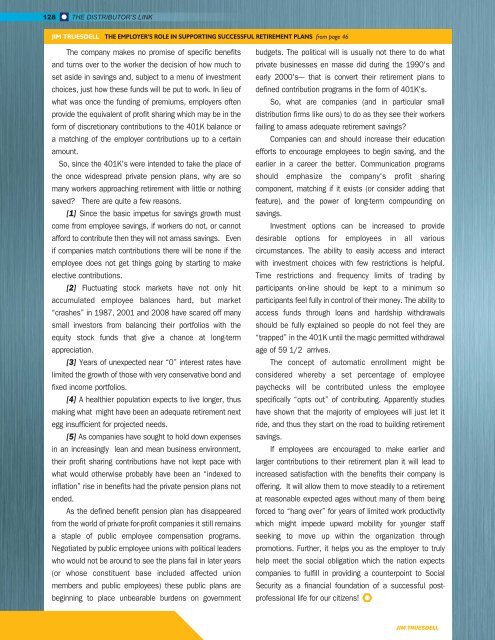WINTER 2016
Distributor's Link Magazine Winter Issue 2016 / Vol 39 No1
Distributor's Link Magazine Winter Issue 2016 / Vol 39 No1
Create successful ePaper yourself
Turn your PDF publications into a flip-book with our unique Google optimized e-Paper software.
128 THE DISTRIBUTOR’S LINK<br />
JIM TRUESDELL THE EMPLOYER’S ROLE IN SUPPORTING SUCCESSFUL RETIREMENT PLANS from page 46<br />
The company makes no promise of specific benefits<br />
and turns over to the worker the decision of how much to<br />
set aside in savings and, subject to a menu of investment<br />
choices, just how these funds will be put to work. In lieu of<br />
what was once the funding of premiums, employers often<br />
provide the equivalent of profit sharing which may be in the<br />
form of discretionary contributions to the 401K balance or<br />
a matching of the employer contributions up to a certain<br />
amount.<br />
So, since the 401K's were intended to take the place of<br />
the once widespread private pension plans, why are so<br />
many workers approaching retirement with little or nothing<br />
saved? There are quite a few reasons.<br />
[1] Since the basic impetus for savings growth must<br />
come from employee savings, if workers do not, or cannot<br />
afford to contribute then they will not amass savings. Even<br />
if companies match contributions there will be none if the<br />
employee does not get things going by starting to make<br />
elective contributions.<br />
[2] Fluctuating stock markets have not only hit<br />
accumulated employee balances hard, but market<br />
“crashes” in 1987, 2001 and 2008 have scared off many<br />
small investors from balancing their portfolios with the<br />
equity stock funds that give a chance at long-term<br />
appreciation.<br />
[3] Years of unexpected near “0” interest rates have<br />
limited the growth of those with very conservative bond and<br />
fixed income portfolios.<br />
[4] A healthier population expects to live longer, thus<br />
making what might have been an adequate retirement next<br />
egg insufficient for projected needs.<br />
[5] As companies have sought to hold down expenses<br />
in an increasingly lean and mean business environment,<br />
their profit sharing contributions have not kept pace with<br />
what would otherwise probably have been an “indexed to<br />
inflation” rise in benefits had the private pension plans not<br />
ended.<br />
As the defined benefit pension plan has disappeared<br />
from the world of private for-profit companies it still remains<br />
a staple of public employee compensation programs.<br />
Negotiated by public employee unions with political leaders<br />
who would not be around to see the plans fail in later years<br />
(or whose constituent base included affected union<br />
members and public employees) these public plans are<br />
beginning to place unbearable burdens on government<br />
budgets. The political will is usually not there to do what<br />
private businesses en masse did during the 1990's and<br />
early 2000's---- that is convert their retirement plans to<br />
defined contribution programs in the form of 401K's.<br />
So, what are companies (and in particular small<br />
distribution firms like ours) to do as they see their workers<br />
failing to amass adequate retirement savings?<br />
Companies can and should increase their education<br />
efforts to encourage employees to begin saving, and the<br />
earlier in a career the better. Communication programs<br />
should emphasize the company's profit sharing<br />
component, matching if it exists (or consider adding that<br />
feature), and the power of long-term compounding on<br />
savings.<br />
Investment options can be increased to provide<br />
desirable options for employees in all various<br />
circumstances. The ability to easily access and interact<br />
with investment choices with few restrictions is helpful.<br />
Time restrictions and frequency limits of trading by<br />
participants on-line should be kept to a minimum so<br />
participants feel fully in control of their money. The ability to<br />
access funds through loans and hardship withdrawals<br />
should be fully explained so people do not feel they are<br />
“trapped” in the 401K until the magic permitted withdrawal<br />
age of 59 1/2 arrives.<br />
The concept of automatic enrollment might be<br />
considered whereby a set percentage of employee<br />
paychecks will be contributed unless the employee<br />
specifically “opts out” of contributing. Apparently studies<br />
have shown that the majority of employees will just let it<br />
ride, and thus they start on the road to building retirement<br />
savings.<br />
If employees are encouraged to make earlier and<br />
larger contributions to their retirement plan it will lead to<br />
increased satisfaction with the benefits their company is<br />
offering. It will allow them to move steadily to a retirement<br />
at reasonable expected ages without many of them being<br />
forced to “hang over” for years of limited work productivity<br />
which might impede upward mobility for younger staff<br />
seeking to move up within the organization through<br />
promotions. Further, it helps you as the employer to truly<br />
help meet the social obligation which the nation expects<br />
companies to fulfill in providing a counterpoint to Social<br />
Security as a financial foundation of a successful postprofessional<br />
life for our citizens!<br />
JIM TRUESDELL

















